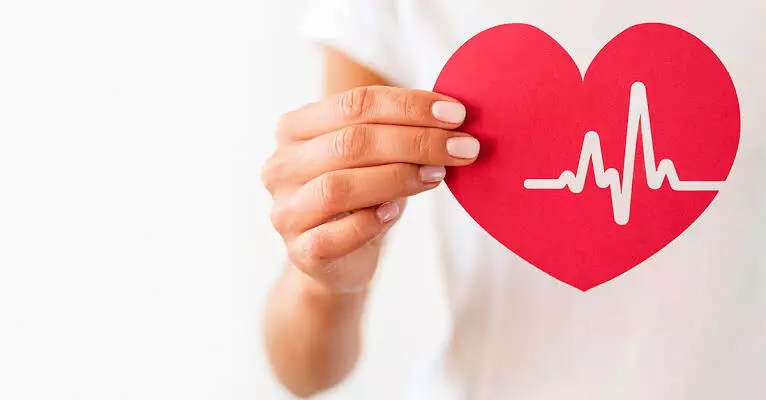World Heart Day: How gender stereotypes are making things worse for women's heart health
Medical experts point out that the protective hormone estrogen is no longer a safeguard from cardiac ailments for women and both genders are equally at risk
By Sulogna Mehta
Representational Image
Hyderabad: Gender stereotypes exist in many aspects and the heart is no exception. The common notion is that pre menopausal women are naturally protected against heart diseases, unlike men.
Medical experts point out that the protective hormone estrogen is no longer a safeguard from cardiac ailments for women and both genders are equally at risk. And nowadays, just like younger men, younger women are prone to cardiovascular diseases.
A few months ago, fit actress Sushmita Sen had suffered a heart attack and underwent angioplasty. There has been a spate of gym-freak youngsters in their 20s and 30s who have suffered heart attacks and these include women as well.
Cardiac ailments in women can range from sudden cardiac arrest, heart attacks, cardiac electrical signal problems, weak heart muscles, and damaged valves.
So why have women become susceptible to cardiac ailments in recent years?
Multiple risk factors have escalated
Socio-economic dynamics shift: As the socio-economic dynamics have changed, many women are living a highly stressful, sedentary life, smoking and eating an unhealthy diet. Around two to three decades ago, women were not so much into smoking, vaping, or binging junk food so frequently as now, and job stress and lack of physical exercise have been added to make matters worse. As a result, obesity, hypertension, high cholesterol, iron deficiency, and diabetes have taken over like an epidemic. All these lifestyle diseases make one more vulnerable to malfunctioning of the heart. The pregnant mother’s health can also be an indication for future heart problems, especially if she develops preeclampsia which is very high BP during pregnancy.
Socio-cultural roadblocks
Gender disparity is prevalent, especially in rural areas, when it comes to taking care of one’s health and access to medical care. Women are often conditioned into thinking that taking care of husbands and children at the cost of their health is a virtue. Therefore, they tend to ignore subtle symptoms and health problems like indigestion and back pain and their access to timely treatment is also limited. “Depression is also an undetected, overlooked potential risk factor for cardiovascular diseases, and due to the stigma and social biases, women shy away from getting treated. This depression, in turn, creates conditions that are unfavorable for the heart,” said Dr. Rajesh Thachathodiyl, senior interventional cardiologist, professor, and head of adult cardiology, Amrita Hospital, Kochi.
Genetic factors and coronavirus
Genetic predisposition and family history of CVD are causing heart attacks, stroke, and such diseases among the relatively young age bracket. “Genetic markers can be identified for timely intervention and prevention. Also, though vaccines have been beneficial for most, some studies indicate that a minuscule proportion of the genetically predisposed population have abnormal blood clotting response to certain components of the vaccine and has to be specially treated,” said Dr. Hisham Ahamed, associate professor, and consultant cardiologist, Amrita Hospital while speaking at a webinar on heart health.
Recent studies also say that SARS-CoV-2 infection multiplies in coronary arteries and replicates, causing long-term inflammation in the vessels, thereby enhancing the risk of CVD.
Pooled cohort equation and Risk Enhancers
Medical technology has made it possible to calculate the chances of developing heart ailments in the future through pulled cohort equation (PCE) app and risk enhancers. Depending on the scores, preventive treatment can be commenced.
Explaining it, Dr P Rajendra Kumar Jain, head of the department and senior consultant cardiologist at KIMS Hospitals said, “Take for example, a 40-year-old opts for heart risk evaluation. She is fit but her mother had developed heart ailments when she was 50 years old. For PCE, parameters such as the person’s age, race (African, American, Asian, etc.), status of diabetes, hypertension, cholesterol, and smoking habits are checked. If the score is more than 20 %, then the person is put on statin (anti-cholesterol) drugs to lower the risk. If the score from the parameters is between 7.5 % and 20 %, that is an intermediate risk, then the next step is to check the risk enhancers. If the person has any two of the risk-enhancing factors, then the intermediate risk becomes high risk and they should start taking prescribed medicines as a preventive therapy for future heart issues. In her case, she already has two risk enhancers namely - a family history and she is of South Asian origin.”
Risk Enhancers in heart ailments
Any family history of men less than 55 years and women less than 65 years getting atherosclerotic cardiovascular disease (ASCVD) or cholesterol plaque in arteries, coronary artery disease (CAD), or coronary thrombosis (CT) in the family.
South-Asian ancestry (which almost all Indians have)
Premature menopause, before 40 years of age.
Someone who had preeclampsia or very high BP during pregnancy.
Metabolic syndrome like obesity (waist circumference above the normal level), high BP, blood glucose level, high cholesterol and triglyceride level.
Any person having chronic inflammatory disorders like rheumatoid arthritis or lupus.